7 Growth Stages of Tomato Plant
Growing vegetables that I use in my daily life in my own garden is my favorite hobby. It helps me learn a lot about nature and also helps me get through daily-life worries. Among these, my favorite one is tomatoes.
They are interesting to grow and once grown they provide an attractive red look to my garden. Understanding the various growth stages of tomato plants significantly helps me enhance my tomato growing success. Let’s begin our journey towards growing tomatoes through different developmental phases.
Tomato (Solanum lycopersicum) is one of the most popular widely grown vegetables in the world. Its different varieties are adapted to a wide range of soils and climate. It has various uses and no one can deny its importance. They are adaptable with almost every food item. Widely used in salads and sauces like ketchup.
For more information about houseplants you can visit: 15 Shrubs With Red Leaves
Such as cherry tomatoes provide an elegance to your dining as well as garden due to their small size. Larger varieties can be used in making soups and most importantly biotechnologically produced tomatoes have significance in curing heart diseases and cancer.
Various varieties of tomato plants are grown all around the world such as roma tomatoes, grape tomatoes, plum, heirloom tomatoes, green tomatoes, cherry tomatoes and so on. Each variety has its own significance.
Importance and Health Benefits of Tomatoes:
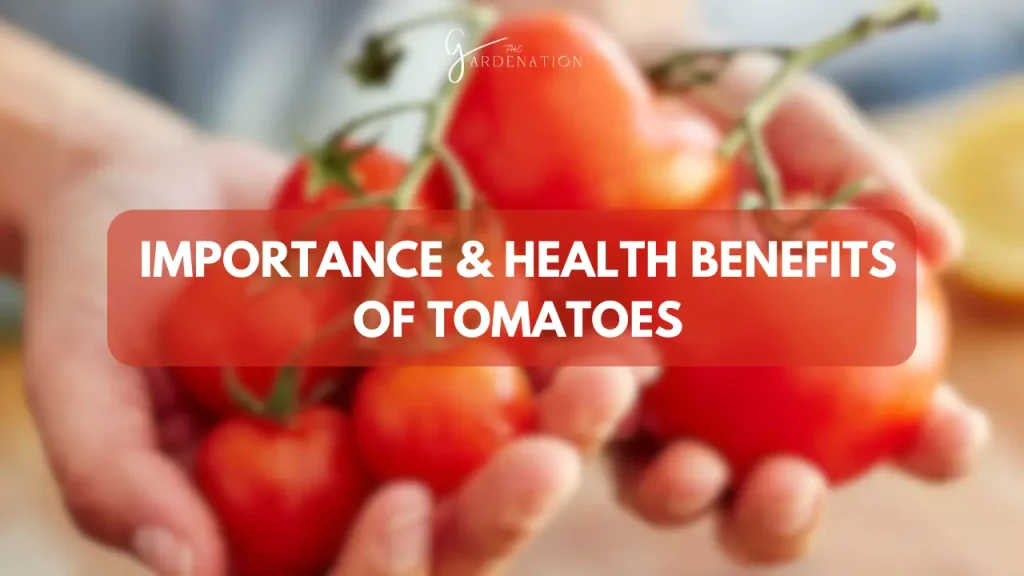
- Tomatoes contribute to a balanced diet with various health benefits. They contain 2.5% sugar content in ripe fruit as well as ascorbic acid and a beautiful portion of total amino acids.
- Overall, they are rich in minerals, essential amino acids, sugars and fibers.
- Antioxidants such as lycopene, beta-carotene and Vitamin-C are also present. That helps neutralize harmful radicals in the body reducing the risk of chronic diseases like cancer, diabetes and heart diseases.
- Tomatoes are a good source of vitamin-A and b-carotene that is essential for healthy eyes.
- About the importance of tomatoes, it is one of the versatile crops adapting to various climates and soils making it a highly important crop.
- Its ripe fruits have great importance in the food industry for making processed food such as puree, tomato paste, ketchup, sauces, soup and syrup.
Growing Tomato Plants
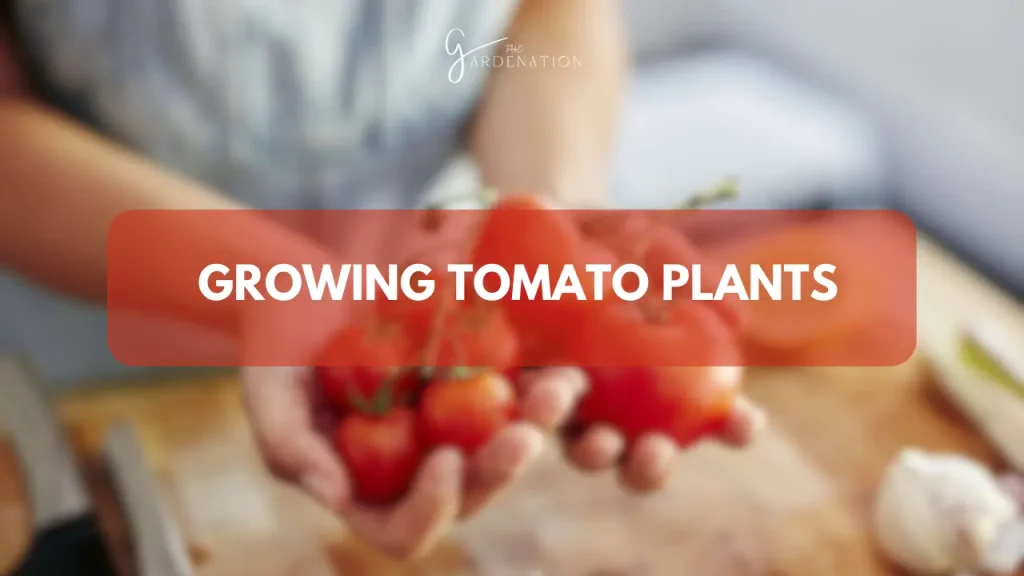
Tomato is a warm season crop. Optimum temperature for its cultivation is 68℉-75℉. It is highly intolerant to frost. Too low temperatures and too high temperatures are not favorable for their growth.
Technically, tomatoes can be grown in any season as it is a day-neutral plant. But they must be protected from frost. Best months to take tomato crops are in July and October-November. It grows well in all kinds of soils. But for early crops I would recommend sandy soil and for best production use soils rich in organic matter. The pH of soil must be 6.0-7.0. Tomato is slightly tolerant to acidic soil too (pH 5.5) making it more versatile.
Process of Seed Germination
After getting the best quality seed for tomatoes, treat them with fungicide. Take seeds in a plastic bag, add equal amounts of water and fungicide and wash seeds inside the bag. After seed treatment, seeds are ready for nursery.
Before transplanting in the garden one must grow seed in nursery trays.
- Take fine quality mulch in each planting hole or section of tray.
- Add 2-3 seeds in each section.
- After proper caring for 25-30 days they sapling is ready to be transplanted.(number of days can vary depending upon variety of tomatoes)
- Note there must be 4-6 true leaves and the plant must be tall enough to withstand the harshness of the environment.
Once plants are ready to be transplanted. Prepare soil in the garden. Plough the soil to break all the clods until it turns into fine tilth form. Make holes to plant tomatoes. Adding a small amount of DAP before planting will improve soil nutrient status. The soil must be moist and water the plant after transplanting. Consider the weather conditions of the outdoors before transplanting.
Growth Stages:
There are several tomato varieties suited for growing season such as:
1) Early Season Varieties
These varieties are bred to mature quickly, making them ideal for regions with shorter growing seasons or for gardeners who want to harvest tomatoes early in the season.
Examples: Early girl, Matina
2) Mid-Season Varieties
These varieties typically take a bit longer to mature than early-season types but still produce fruit relatively early in the summer.
Examples: Jet Star, Better Boy.
3) Late Season Varieties
These varieties take the longest time to mature but often produce larger yields and fruits with excellent flavor. They are ideal for season with longer growing seasons
Examples: Brandywine, Cherokee
These varieties go through several distinct growth stages from seed to harvest. Typically there are 8 growth stages for tomato plants.
These growth stages along with their approximate timings are given ahead;
| Stages | Approximate Timings |
| Germination | 5-10 days after planting |
| Seedling Stage | 2-3 weeks after germination |
| Vegetative Growth | 3–6 weeks after planting |
| Flowering | 4-6 weeks after planting |
| Pollination | Shortly after flowering |
| Fruit Set | 1-2 weeks after flowering |
| Fruit Development | 4-8 weeks after fruit set |
| Ripening | 1-2 weeks after fruit development |
This is the summary of timings of different growth stages of tomato plants. Whether one is planting indeterminate varieties (vines) or determinate varieties (bushes), the relative timing is almost the same. However, in the case of indeterminate tomatoes the first flowering takes a little longer.
Each growth stage of the tomato plant is explained below:
1. Germination Stage
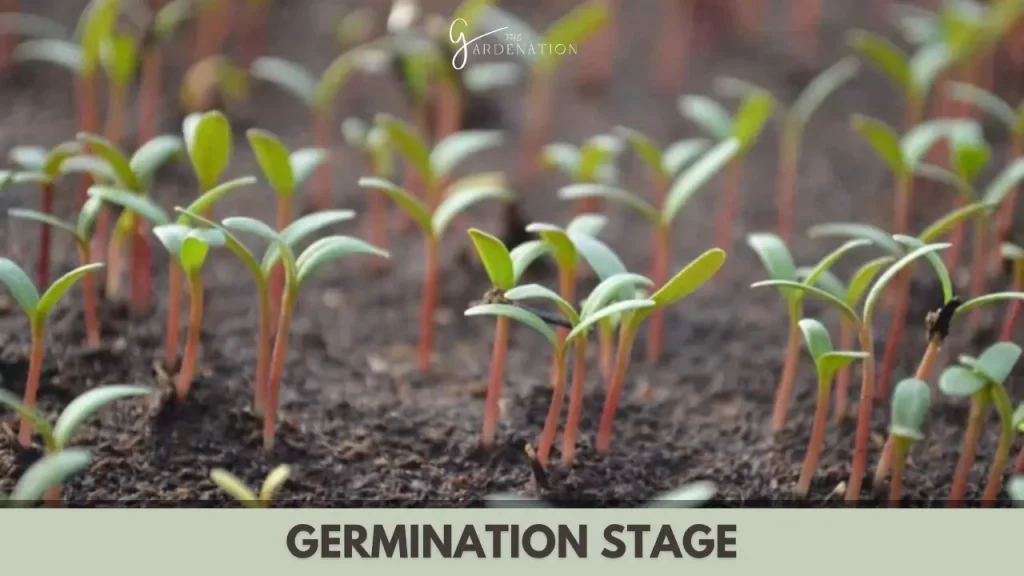
- The process of germination typically takes 5-10 days after planting of the seed. The seed absorbs water and swells and the growth phase starts here.
- Then the outer shell cracks open and a tiny root emerges first, followed by the shoot which is known as the embryonic stem of the seedling. At this stage the seedling is very thin and tiny and has only embryonic leaves visible known as cotyledon .
- Favorable temperature is 68-75℉
2. Seedling Stage
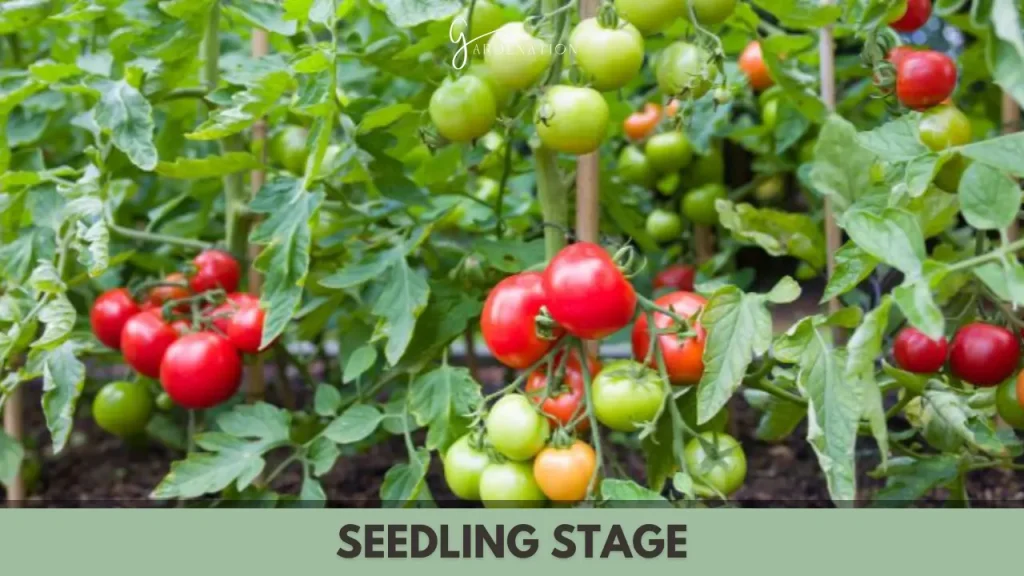
- This is the second stage of tomato growth phase and lasts about 2-3 weeks after germination. The seedlings have only a few cotyledons and may have only the first set of true leaves. This seedling continues to grow, developing its root system, stem and leaves.
3. Vegetative Growth
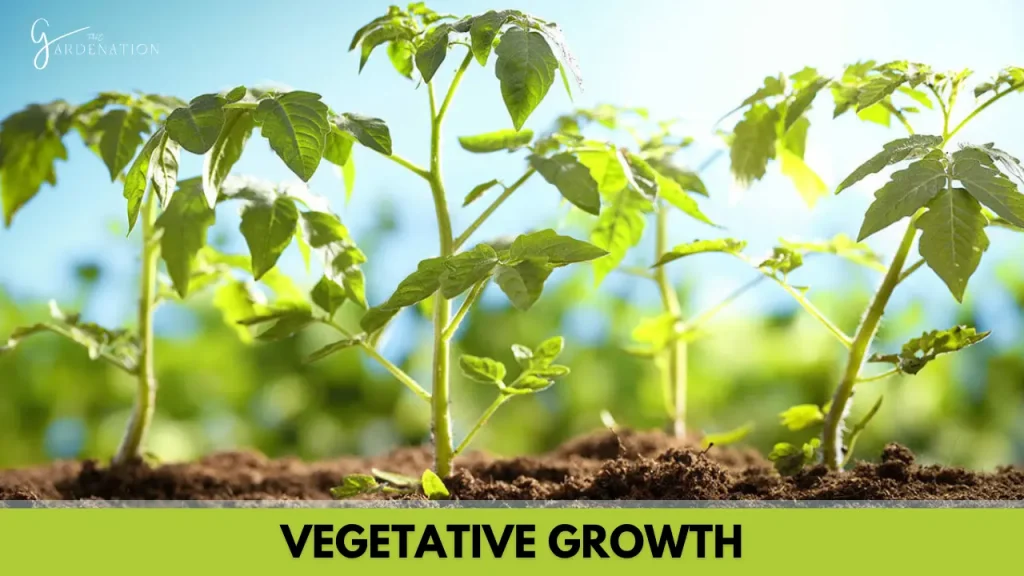
- After completion of the seedling phase, the plant focuses on growing its stems, leaves and roots. This phase lasts 3-6 weeks after planting depending on provided conditions.
- In this phase, there is rapid increase in growth of stem, leaves and roots and there is significant increase in the number of branches with the plant growing taller.
- Proper nutrition and a balanced environment is necessary in the growth phase of a plant. As any fluctuation in the growth phase ultimately delays and affects the flowering. That can result in loss of yield.
4. Flowering and Pollination
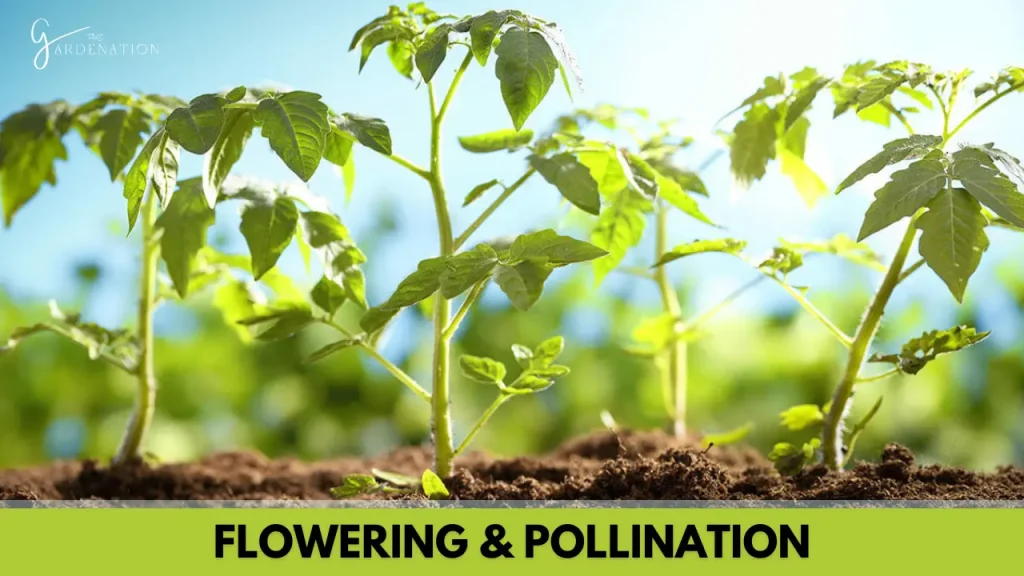
- In the previous phase the plant has completed its vegetative growth, marked as growth of stem, roots, branches and leaves. Now the plant has become fully matured it will move towards the reproductive phase, marked as production of flowers.
- Flower buds typically begin to appear around 4-6 weeks after planting depending upon the health of the plant. These buds then develop into flowers representing the transition between vegetative to reproductive phase.
- These flowers are of yellow color consisting of both male and female reproductive parts. So they are capable of self pollination. Although pollinators can enhance the process.
5. Fruit Set
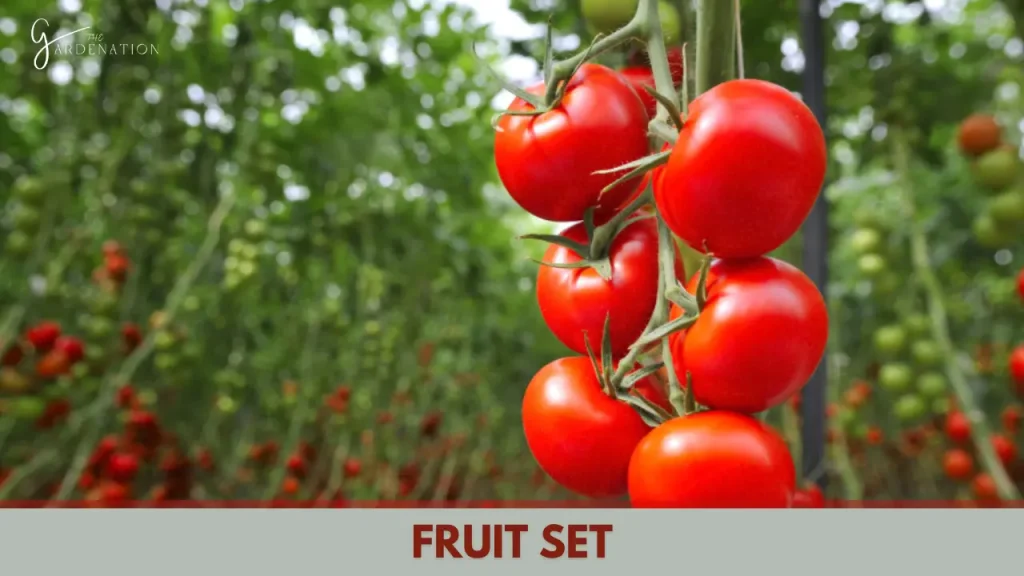
- After the successful completion of pollination, the ovary ripens into an ovule that is going to develop into fruit. The ovule increases its size and flower petal falls leaving only fruit on shoot.
- This process forms tiny green fruits that increase gradually over time in size and as more and more flowers are pollinated more fruits are formed. The process of the fruit set takes place approximately 1-2 weeks after pollination.
6. Fruit Development
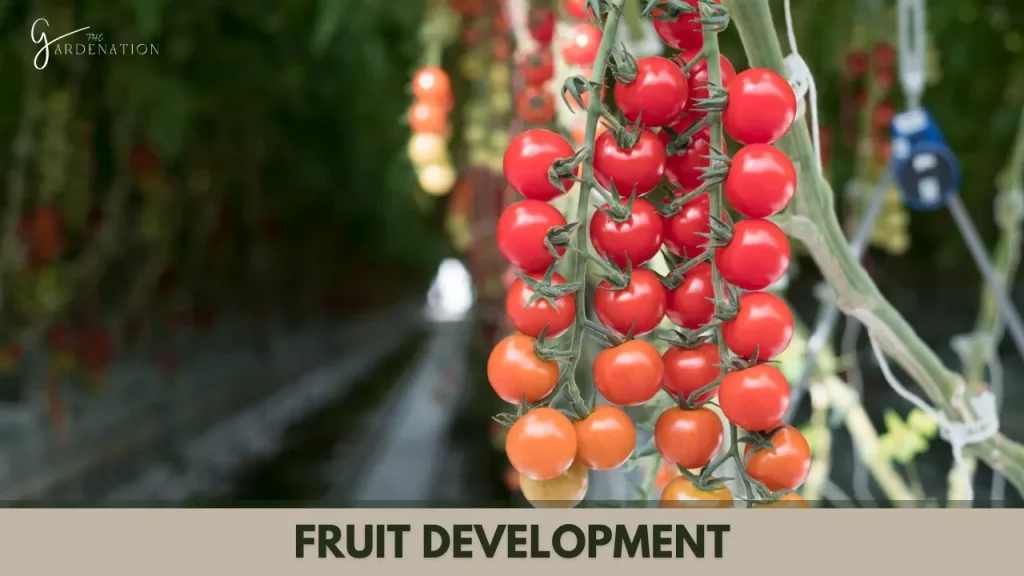
- Now I have witnessed the formation of fruit on my plant. Now I will witness my plant undergoing several color changes, eventually itching its mature color.
- In 4-8 weeks of fruit set, the tomatoes continue to accumulate sugars, acids and every nutrient that contributes to its status and develop into red, yellow or orange fruit.
7. Ripening
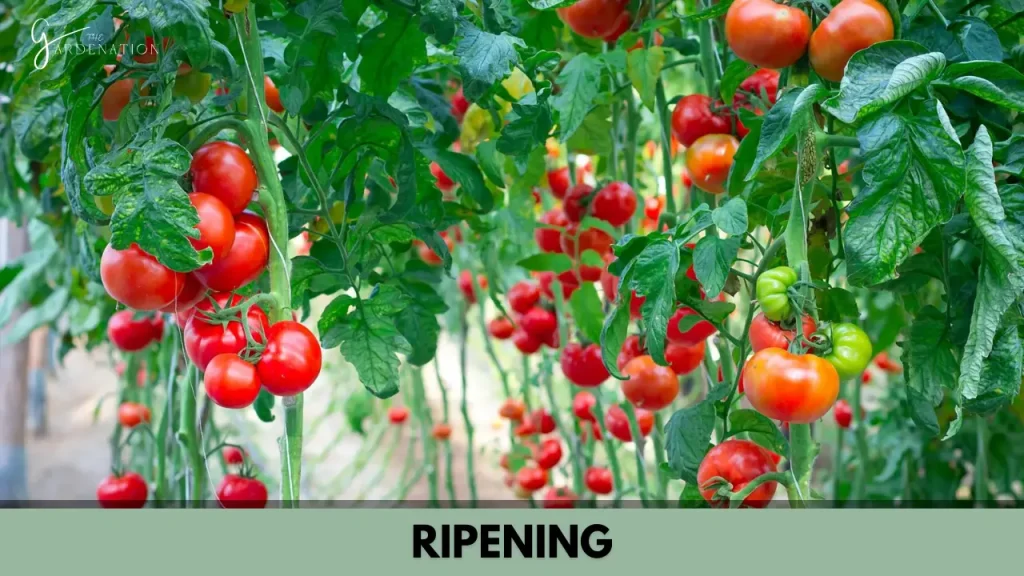
- This is the final stage of growth of tomatoes. It occurs when the fruit is fully matured and becomes ready to harvest. This process takes place 1-2 weeks approximately after fruit development.
- It highly depends on factors such as temperature and sunlight. Ripe tomatoes soften and their color develops fully, indicating that they are sweet and flavorful.
Harvesting Tomatoes:
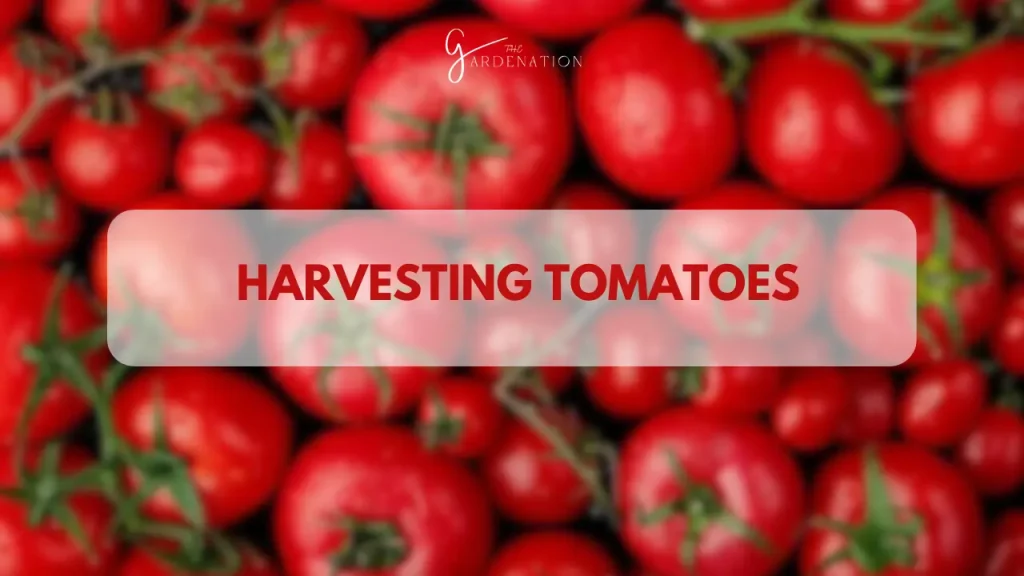
The last step in growing tomatoes is harvesting them. From germination to harvesting the whole process takes 90-140 days depending on the varieties and growing season.
I would recommend picking tomatoes not on their peak red color but slightly before their full color development. It will store the natural flavor for much longer, prevent tomatoes from being rotten and one can store them for a longer period. Although , it’s just a personal recommendation everyone has their own preferences.
Frequently Asked Questions about Growth Stages of Tomato Plant
Why did my Tomato Plant Wilt?
There could be various reasons for wilting of tomato plants including over-watering, under watering, heat stress, over fertilizer, not considering proper growth conditions like favorable soil climate and nutrient status.
How can I get a Healthy Tomato Plant?
Health of the plant firstly depends on the cultivar selected. Always select the best cultivar after consulting the nursery. Then growth condition proper care and fertilizer management affects the health of the tomato plant.
Conclusion:
Tomato is a very versatile crop that is grown all over the world. It is grown usually in 8 stages marked as germination taking place 5-10 days after planting, seedling phase 2-3 weeks after germination, vegetative growth 3-6 weeks after planting , flowering and pollination in 4-6 weeks, fruit setting in 1-2 weeks after flowering then fruit development continues for 4-8 weeks and ripening 1-2 weeks after completion of fruit development. And we get ripened red, orange or yellow tomatoes depending upon the cultivar grown.

